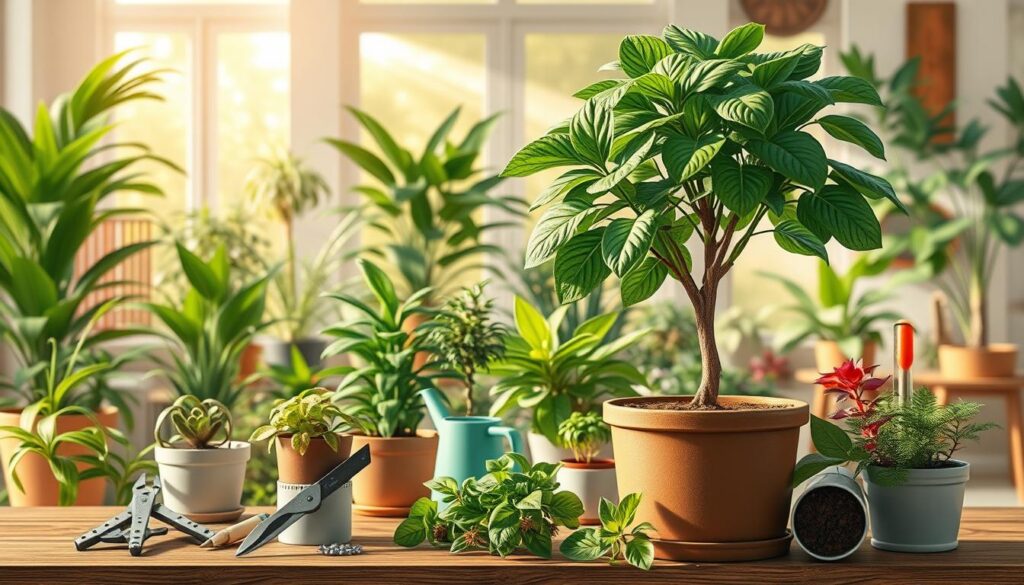Anúncios
Welcome to your essential guide for keeping plants healthy. We crafted this guide to boost your knowledge of houseplants. It provides the gardening tips you need for a thriving indoor garden. Indoor gardening is getting popular. Many find that plants not only make their homes look better but also help with plant health and clean the air.

Seek App
If you’re new or already love taking care of plants, this guide is for you. It’s packed with all you need to know for great plant care. So, get ready to turn your home into a lush, green space!
Anúncios
Understanding the Basics of Plant Care
Plant care involves light, water, and nutrients. Indoor plants need conditions similar to their natural homes. It’s important to know what each plant species requires.
How much water and light a plant gets is crucial. Too much water causes root rot, and too little light slows growth. Beginners should try easy plants like snake plants and pothos.
Anúncios
Learning these basics helps people take better care of plants. Customizing care for each plant helps them live longer and look better. Knowing about different plants, like succulents and ferns, leads to better gardening.

Choosing the Right Houseplants
Choosing the right plants for your home means checking if they fit with your space. For beginners, easy-care plants are great. These tough plants need little attention but make your home look vibrant. Snake plants, philodendrons, and spider plants adapt well to different light and humidity, perfect for starters.
Think about what you like and how much time you can give. Find plants that grow well in your home with little work. With the right plants, your indoor space can turn into a peaceful, green spot.
Light Requirements for Healthy Plants
Knowing what light different plants need helps them stay healthy. Some need lots of sun, while others grow well in the shade. It’s important to understand light level terms because they help you know where to place plants and how to care for them.
Many plants love bright, indirect sunlight. Put them near windows with curtains that let light in softly. On the other hand, some plants, like snake plants or pothos, do well in low light. They are great for spots without much sun.
Adding artificial light helps plants in areas with little sunlight. Grow lights make up for the lack of natural light. Also, turning plants regularly lets every side get light, helping them grow evenly.
When you pay attention to light needs, your plants will grow healthy and look beautiful.
Watering Techniques for Different Plants
Knowing how to water different plants right is key for their health and growth. Every plant needs a certain amount of water, which is why we must find the best way to water them. The soak and dry method is often recommended to meet the unique needs of your plants.
Understanding Soak and Dry Method
The soak and dry method means watering a plant fully until water comes out of the pot’s bottom. This gets the soil completely wet. Then, you wait for the soil to partly dry before watering again. This method is good for the roots and helps avoid too much water, which can cause problems.
Signs of Over-watering vs. Under-watering
It’s important to know the signs of giving too much or too little water to plants. Signs of too much water include leaves that wilt, turn yellow, or mold on the soil. If a plant doesn’t get enough water, the leaves might droop or have dry edges. Checking how moist the soil is can tell you the best time to water. This keeps your plants healthy.
Optimal Soil and Fertilizer for Growth
Choosing the right soil and fertilizer is key for plant growth. It’s important to know what your plants need, like if they’re succulents or tropical. They all do best in soil that drains well but keeps enough nutrients.
What Soil Works Best for Different Plant Types?
Plants need different kinds of soil to grow well. For example:
- Cacti and succulents like sandy soil for quick drainage.
- Tropical plants do well in soil with lots of organic matter to hold moisture.
- Herbs prefer loamy soil that keeps the right balance of water and nutrients.
Knowing the right soil for your plants makes a big difference in their growth and health.
Fertilizing Guidelines for Healthy Growth
Fertilizing gives plants the nutrients they need. Use organic fertilizers that match your plants’ needs. Here are some tips:
- Fertilize in spring and summer, when plants grow most.
- Always follow the instructions to avoid harming your soil.
- Slow-release fertilizers give a constant flow of nutrients.
Temperature and Humidity: Creating the Ideal Environment
Houseplants’ health depends on the right temperature and humidity levels. Most do well in 65°F to 75°F. Avoid very hot or very cold temps, as they can hurt your plants. Be sure to keep them away from cold drafts and direct heat.
Humidity is key for plant life. Most houseplants like it when the air has 40% to 60% humidity. If your home’s air is dry, your plants may seem unhappy, showing droopy leaves or brown edges. You can boost the air’s moisture by:
- Using a humidifier to keep moisture steady.
- Putting plants close to each other to increase air moisture.
- Setting pots on pebble-filled trays with water for a mini-humid zone.
- Spraying plants with water to up humidity for a bit.
Looking after your plants’ temperature and humidity needs helps them thrive. A balanced indoor climate keeps your plants healthy and growing strong.
Plant Care: Maintenance Tips for a Thriving Garden
Effective plant maintenance is key for plants that are vibrant and healthy. Pruning, repotting, and caring for leaves help plants do well in their space. Knowing when and how to do these tasks is important for their beauty and life span.
Pruning and Repotting Techniques
Pruning is essential for plant health. It encourages new growth, gets rid of dead or sick branches, and makes plants look better. It’s best to prune in spring or early summer. Always use clean, sharp tools for clean cuts that heal quickly.
As plants grow, they may need bigger pots. This lets roots spread and stops them from getting too cramped. If you see roots coming out of the bottom or if the plant stops growing well, it might be time to repot.
Cleaning Leaves for Improved Health
Leaf care is very important but often forgotten. Dust on leaves can block sunlight, which plants need to grow. Wipe leaves with a wet cloth or spray them with water to remove dust and bugs. Doing this every month helps plants get enough light and stay healthy and bright.
Controlling Pests and Diseases in Houseplants
Keeping houseplants healthy means being on the lookout for pests and diseases. Check your plants often to catch problems early. Knowing the common threats and how to fight them with organic methods is key.
Common Pests and Organic Solutions
Some usual pests you might see are:
- Aphids
- Spider mites
- Mealybugs
For an organic approach to pest control, you can use:
- Neem oil, which stops pests from growing and laying eggs
- Insecticidal soap, which works well on insects with soft bodies
Identifying and Treating Plant Diseases
Plant diseases show up in different ways, like wilting, changes in color, or odd growths. Some common problems are:
- Root rot, which is usually due to too much water
- Powdery mildew, seen as white spots on the leaves
To handle these diseases, water your plants correctly and make sure they have good air flow. If a plant is sick, cut off the sick parts. You might also need to use treatments that kill fungi to help the plant get better.
Conclusion
This plant care guide showed how to keep your indoor garden healthy. We’ve seen it’s crucial to know what each plant needs. This means understanding the right amount of light and the best soil.
Choosing plants that fit well in your space is a big step towards success. It’s like making sure they have the perfect home.
Keeping your plants healthy means regular care. This involves watering them just right and keeping an eye on the temperature. It’s also about fighting off pests before they cause harm.
These tips will make your indoor plants thrive. It’s about putting in the effort and loving the process.
Caring deeply for your plants can fill your home with life. It’s all about meeting their needs, fighting off pests, and checking on them often. If you take plant care seriously, your home will become a beautiful green space.



